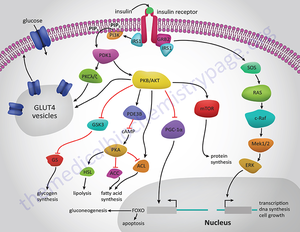Blood Glucose Regulation
Introduction
Blood glucose regulation involves maintaining blood glucose levels at constant levels in the face of dynamic glucose intake and energy use by the body. On average this target range is 60-100 mg/dL for an adult although people can be asymptomatic at much more varied levels. In order to maintain this range there are two main hormones that control blood glucose levels: insulin and glucagon. Insulin is released when there are high amounts of glucose in the blood stream. Glucagon is released when there are low levels of glucose in the blood stream. There are other hormones that effect glucose regulation and are mainly controlled by the sympathetic nervous system. Blood glucose regulation is very important to the maintenance of the human body. The brain doesn’t have any energy storage of its own and as a result needs a constant flow of glucose, using about 120 grams of glucose daily or about 60% of total glucose used by the body at resting state. (Berg,2002) With out proper blood glucose regulation the brain and other organs could starve leading to death.
Introduce the topic of your paper. State your health service question, and explain the biomedical issues.
Section 1
Include some current research, with at least one figure showing data.
By [Name]
Section 2
Include some current research, with at least one figure showing data.
Section 3
Include some current research, with at least one figure showing data.
Conclusion
References
Authored for BIOL 291.00 Health Service and Biomedical Analysis, taught by Joan Slonczewski, 2016, Kenyon College.

